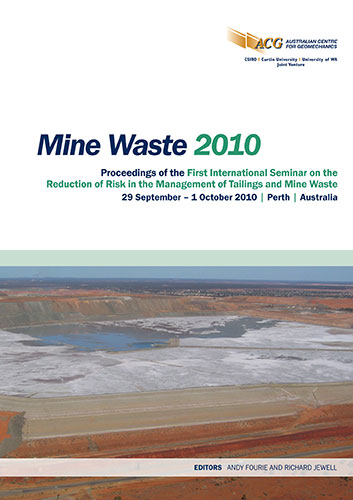Case study — tailings dam construction in an arctic climate

|
Authors: Esford, F; Bedell, P; Lamontange, E |
DOI https://doi.org/10.36487/ACG_rep/1008_16_Esford
Cite As:
Esford, F, Bedell, P & Lamontange, E 2010, 'Case study — tailings dam construction in an arctic climate', in R Jewell & AB Fourie (eds), Mine Waste 2010: Proceedings of the First International Seminar on the Reduction of Risk in the Management of Tailings and Mine Waste, Australian Centre for Geomechanics, Perth, pp. 181-191, https://doi.org/10.36487/ACG_rep/1008_16_Esford
Abstract:
Agnico-Eagle Mines Limited, operates the Meadowbank Gold Mine, in Nunavut, within the arctic region of Canada where permafrost is widespread. Construction of their mine facilities began in 2008 and production commenced in the first quarter of 2010. The mine will consist of a series of open pits, with conventional processing and slurried tailings deposition within the tailings storage facility. The tailings facility is being constructed in stages through a series of perimeter dams and staged raises to provide adequate tailings storage capacity. The 2009 construction season included the construction of Stage 1 of one such structure, ‘Saddle Dam 1’, a 10 m high and 250 m long, lined rockfill structure, with Stage 2 to be constructed in 2010 to a height of 20 m and an overall length of 400 m. The geotechnical investigation determined that soil thicknesses were up to 12 m with permafrost below the active layer (approximately 1–2 m) and the upper 5 m being ice-rich material. The dam was founded on bedrock on the abutments, and on-ice poor soils within the main body of the dam. Ice-rich soils were blasted and excavated from beneath the upstream portion of the dam foundation. Blanket filters were placed above this area followed by the upstream filters and the installation of a linear low density polyethylene (LLDPE) liner on the dam face. The LLDPE liner was installed at temperatures between -15 and -25°C. This paper presents the case study for the successful construction of the structure in challenging arctic conditions.
References:
ASTM D 6392-08 (2008) Standard Test Method for Determining the Integrity of Non-reinforced Geomembrane Seams
Produced Using Thermo-Fusion Methods, ASTM International (American Society for Testing and Materials).
Canadian Dam Association (CDA) (2007) Dam Safety Guidelines, Canadian Dam Association.
Management and Operations
Mine Waste 2010, Perth, Australia 191
Giroud, J.P., Soderman, K.L. and Monroe, M. (1993) Mechanical Design of Geomembrane Applications, in
Proceedings Geosynthetics ’93 Conference, Vol. 3, Vancouver, Canada, March-April 1993, pp. 1455–1468.
Mills, J.A. and Stang, J.R. (1997) Temperature Corrected Tensile Strengths for Geomembrane Filed Seams, in
Geosynthetics 1997, pp. 439–452.
Richards, E.A., Scott, J.D. and Chalaturnyk, R.J. (1985) Cold Temperature Properties of Geomembranes, in
Proceedings, Second Canadian Symposium on Geotextiles and Geomembranes, Edmonton, Alberta.
Case study — tailings dam construction in an arctic climate F. Esford et al.
192 Mine Waste 2010, Perth, Australia
© Copyright 2026, Australian Centre for Geomechanics (ACG), The University of Western Australia. All rights reserved.
View copyright/legal information
Please direct any queries or error reports to repository-acg@uwa.edu.au
View copyright/legal information
Please direct any queries or error reports to repository-acg@uwa.edu.au